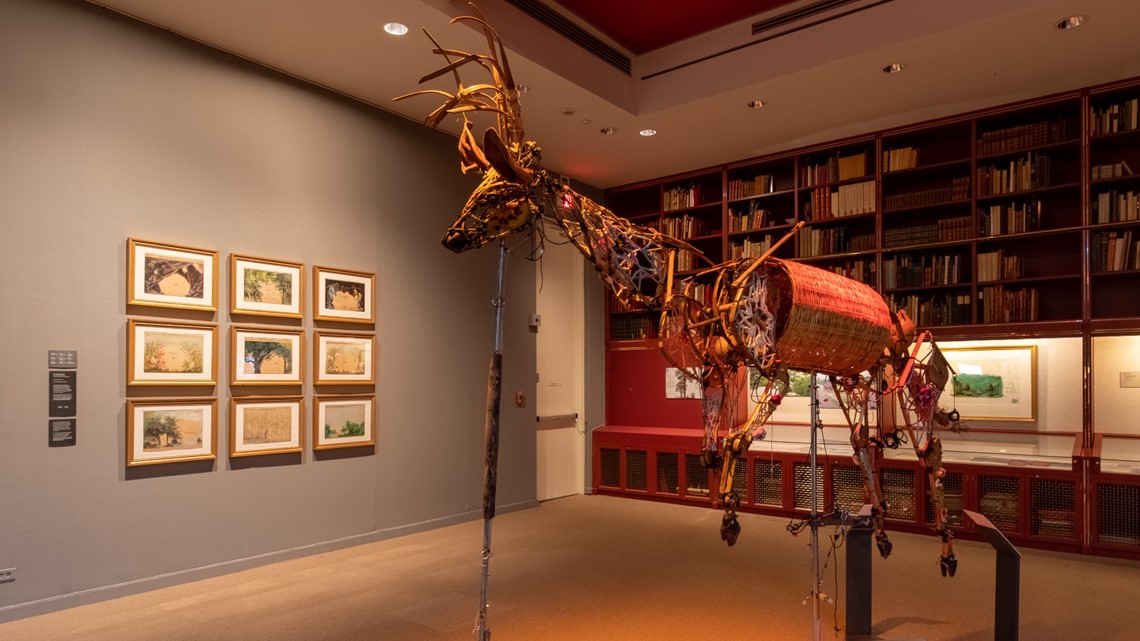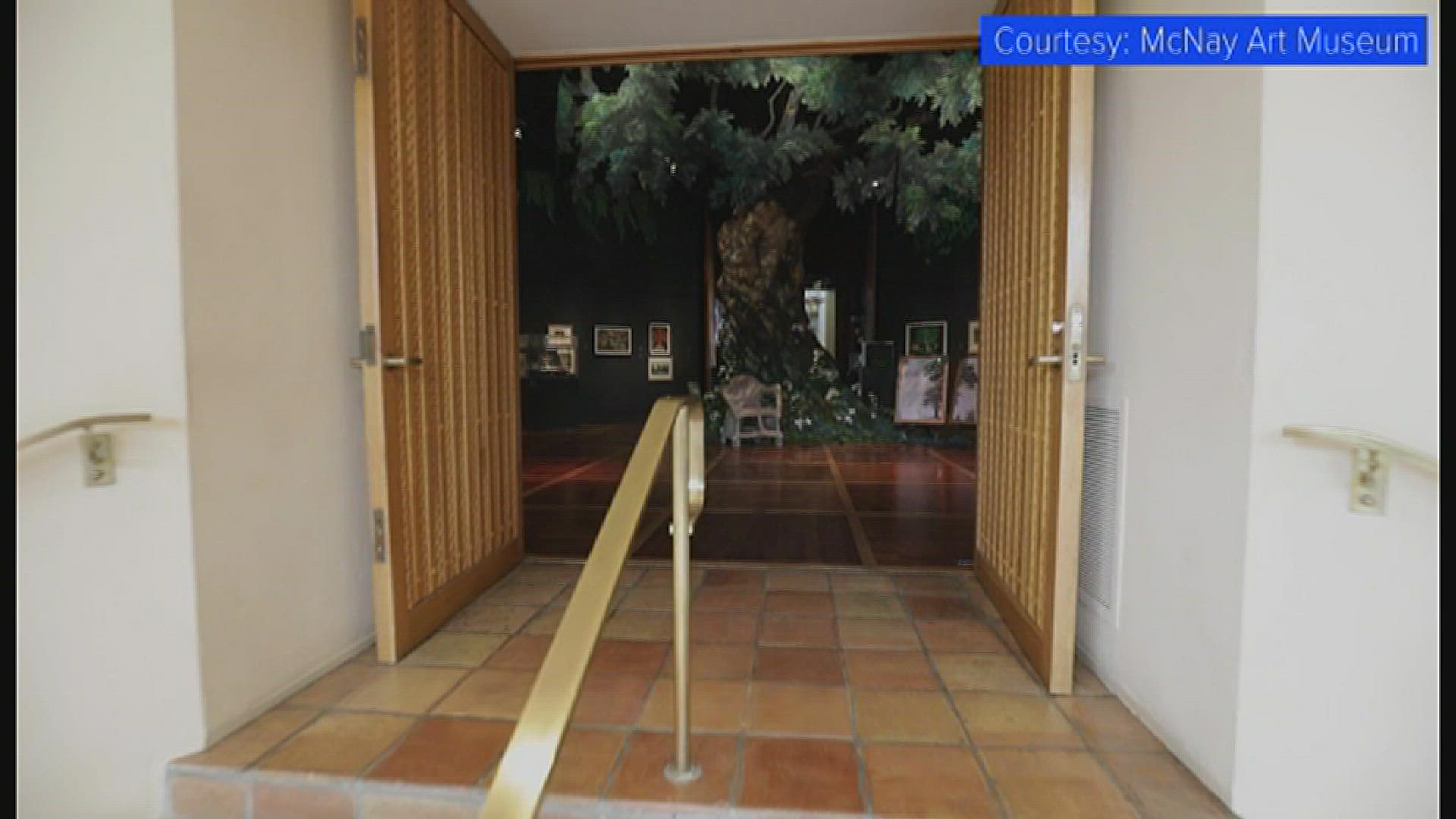SAN ANTONIO — If an art museum’s mission is figuratively rooted in collection, its trunk nourished by preservation and its limbs stretched through exhibition, one ongoing McNay display is proof that a work’s leaves can also yield fresh color through recreation.
A more literal tree (albeit one made of construction foam and paint) stands 15 feet tall at the center of the museum’s aptly named exhibit “Is It Real? Staging Nature,” and subsequently encourages visitors to consider the imagination and drive which brings illusions of the natural world to vivid life on, well, the theatrical stage.
Not only is the tree the centerpiece; it’s also the impetus for how the 60 other pieces of all shapes, sizes and forms have been carefully organized around it in the McNay’s Brown Gallery, an effort led by Scott Blackshire, curator of the Tobin Collection of Theatre Arts at the museum. It was around the start of his tenure in early 2019 and Opera San Antonio’s run of “Faust” that Blackshire discovered the tree, designed by Houston-based artist Earl Staley in the ‘80s, was going to be discarded after 30 years of shows around the country.
“It was time for this tired, sad set to be retired,” Blackshire said. “And it was going to be retired to the dumpster.”
He got to work to prevent that from happening. With the help of his new employer, they managed to save the tree’s base, igniting a two-year process of envisioning an exhibit which would eventually surround it—literally and thematically. Walk around the gallery where “Staging Nature” will remain housed until Oct. 24, and you’ll find hand-drawn storyboards, blown-up schematics, set designs projected onto walls to bring details into view, elaborate miniatures envisioning the essence of future on-stage props, 3-D dioramas of theatrical productions as envisioned in the mind before it’s absorbed by theatergoers’ eyes.
At the same time, using Staley’s blueprints as a guide while adding their own creative flourishes, McNay’s installation crews got to work recreating the tree’s majesty. Or, that is, as much of its majesty that the gallery’s space would allow.
“The tree itself is supposed to be 30 feet tall,” Blackshire said. “We only have half that space here, so we literally truncated it – pun intended – and then (McNay fabricator) John (Dalton Atkins) took some of the extra branches and created the tree crown.”
It takes only a few minutes to recognize the double-entendre in the exhibition’s name (as well as the curiosity of its question). “Staging Nature” is an exhibit built to show how the process of creating theatrical productions becomes a form of art in itself, via the convergence of multiple mediums.
Blackshire says his goal with exhibits like “Staging Nature” is to show how design is integral to putting on any kind of production at any level, whether it’s a simple ceremony or a prestigious opera.
“We find guests really enjoy learning about the process,” he added. “My goal is to give McNay visitors multiple entry points into understanding not just more about the artworks, but the theater they go to see—what makes them think, what makes them feel, what they might enjoy.”
Other famous productions like Shakespeare’s “A Midsummer Night’s Dream” and Fernand Leger’s “The Progress of Steel” are represented, as well as the kaleidoscopic meaning of design in a theatrical stage play: Set design, costume design, hair design, creature design.
The showing-off of those design elements giving visitors a different kind of backstage pass extends to the exhibit’s 15-foot-tall showstopper itself. Stand right under the tree, and you’ll notice how the overhead canopy (one of its original elements) creates what amounts to an optical illusion of foliage for those standing outside; walk behind the tree, and you’ll be able to see its base materials under the fake flora and fauna.
“It’s a beautiful example of artwork in its own right, but it’s also showing the designer’s process,” Blackshire said.
Meanwhile, “process” took on whole new meaning for the McNay’s installation teams when it came to one particular eye-catching piece: A marionette of a wolf on loan from a Mexican theater group, delicately constructed from a litany of everyday objects like screws, chicken bones, light bulbs and an accordion. It expands the definition of staging nature while fitting right in with the themes of “Staging Nature.”
“I was immediately fascinated by the build, the materials, the way that all these manmade materials could create something so lifelike, so natural-looking,” Blackshire said. “It’s interesting how, as a curator, you see these things and they percolate in your mind over the years and you finally find a way to bring it together in an exhibition.”


Rachel Trevino, the McNay’s had of communications and marketing, said another motivation for “Staging Nature” and similar exhibits is deconstructing the notion of theater as an “elite” art form reserved for the upper class.
“When you experience these exhibitions, they feel like relatable things,” she said. “Like nature, I can get on board with nature. There’s this underlying sort of learning and understanding that is happening, which is beautiful, and it brings theater to life in a different way.”
It takes an artist to realize a piece of art’s potential, which is another way of saying Blackshire tapped his own creativity when designing the exhibit, and – true to how a piece of art tells a story – saw “Staging Nature” as the perfect opportunity to tease the McNay’s plans for its own property. Continue on through the exhibit and alongside one wall you may spot storyboards of a different kind: blueprints for the newly opened Tobin Land Bridge as well as plans for the museum’s reimagined landscaping, set to be unveiled in full later this fall.
“I thought, ‘What a great way to tie in the grounds of the McNay for folks’ enjoyment by bringing in this tree and showing how we stage nature in multiple ways through different artworks.”
Blackshire says McNay visitors can expect the same amount of detailed consideration in the exhibit that’s set to follow “Staging Nature,” “Cities on Stage”—a display which will see this inspiration of organic beauty replaced by the sleekness of urban life, imbued with Alamo City flourishes.
The colors may change and the atmosphere at the Brown Gallery may shift when “Cities on Stage” arrives, but if “Staging Nature” is any indication, it will be another display of artists interpreting the world around them and bringing a memorable vision to life as it may look in an engrossing stage play.
“Sets and costumes are designed to trick you, to help you suspend your disbelief in what you’re seeing,” Blackshire said. “So to see something like this, you have to know a 30-foot tree is not on stage. Yet it is, and it looks completely real.”

